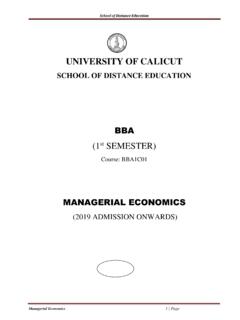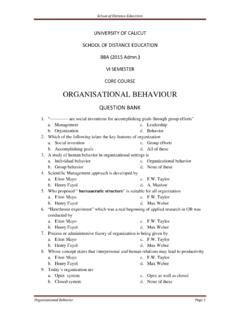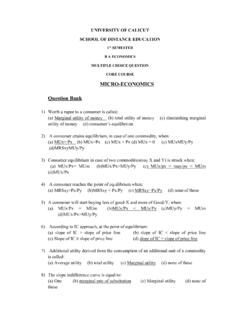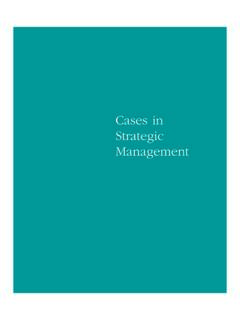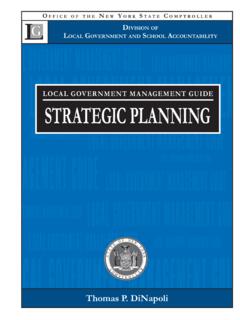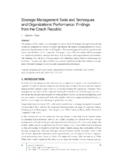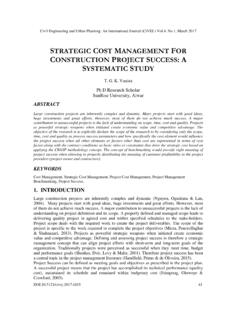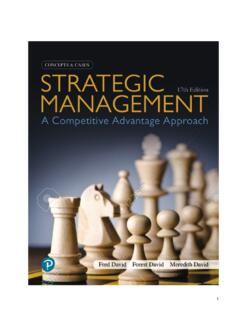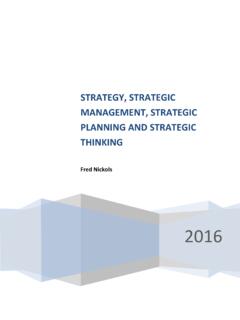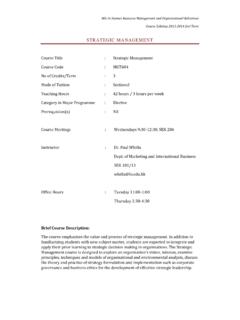Transcription of STRATEGIC FINANCIAL MANAGEMENT M com
1 CALICUT UNIVERSITYSCHOOL OF DISTANCE EDUCATIONS tudy MaterialSTRATEGIC FINANCIALMANAGEMENTM comIV SEMESTER2015 AdmnCALICUT UNIVERSITYSCHOOL OF DISTANCE EDUCATION2038 School of distance educationStrategic FINANCIAL ManagementPage2 CALICUT UNIVERSITYSCHOOL OF DISTANCE EDUCATIONS tudy MaterialMComIV SemesterSTRATEGIC FINANCIAL MANAGEMENTP repared COMMERCE ANDMANAGEMENT STUDIESS crutinised by:DR. YAKOOB. CRESEARCH GUIDESULLAMUSSALAM COLLEGE,AREACODES ettings & Lay Out By:SDE,Computer CellSchool of distance educationStrategic FINANCIAL ManagementPage3 CONTENTSMODULE 1 UNIT 1 FinancialGoals&strategyUNIT 2 Managerial Implications Of Share holder Value creationMODULEIIUNIT 3 FINANCIAL Strategy For Capital StructureUNIT 4 Capital Structure Planning & Decision MakingUNIT 5 Dividend Policy & Value Of The FirmUNIT 6 DividendPolicy&Valuationof FirmsMODULEIIIUNIT 7 Lease financing & Hire PurchaseUNIT 8 FINANCIAL evaluation of leasingUNIT 9 Economics/pros and cons of leasingMODULE IVUNIT 10 Merger strategyUNIT 11 Valuation under mergers and acquisitionModule VUNIT 12 Take over strategyUNIT 13 Takeover code-procedure for takeoverUNIT 14 Takeover defencesUNIT 15' MANAGEMENT buyout-mbo'School of distance educationStrategic FINANCIAL
2 ManagementPage4 School of distance educationStrategic FINANCIAL ManagementPage5 MODULE IUNIT 1 FINANCIAL GOALS AND STRATEGYAll types of organisations require FINANCIAL MANAGEMENT for itssuccessfuloperations. It contains components fortheacquisition, MANAGEMENT , allocationand financing of resources for successful growth of an organisation. Everyorganisation shouldmanage its finances effectively in order to attain its missionand , the fields of STRATEGIC MANAGEMENT and financialmanagement combined together to evolve a new discipline namely StrategicFinancial FINANCIAL MANAGEMENT refers to the study of finance with a longterm perspective which takes into account the STRATEGIC goals of the FINANCIAL MANAGEMENT is a MANAGEMENT approachwhich makesuse ofvarious FINANCIAL tools and techniques in order to come up with a strategicdecision plan.
3 It also ensures the implementation of the chosen strategy so as toachieve the desired ultimate objective of STRATEGIC FINANCIAL MANAGEMENT is to identify thebest possible strategy whichmay result in maximisation oforganisations FINANCIAL MANAGEMENT goes a step further in ensuring that theorganization remainson trackto attain its short-term and long-term goals, whilemaximizing value for its FINANCIAL MANAGEMENT is the identification of the possiblestrategies capable of maximising an organisation s market value and theallocation of scarce capital resources among competing opportunities. It alsoinvolves the implementation and monitoring of the chosen strategy so as toachieve stated FINANCIAL MANAGEMENT is managing an organization's financialresources so as to achieve its business objectives and maximize its FINANCIAL MANAGEMENT involves a defined sequence of steps thatencompasses the full range of a company'sfinances, from setting out objectivesand identifying resources, analyzing data and making FINANCIAL decisions, totracking thevariancebetween actual and budgeted results and identifying thereasons for this variance.
4 The term " STRATEGIC " means that this approach tofinancial MANAGEMENT has a long-term of distance educationStrategic FINANCIAL ManagementPage6 The Chartered Institute of MANAGEMENT Accountants of UK [CIMA]defines STRATEGIC FINANCIAL MANAGEMENT as the identification of the possiblestrategies capable of maximising an organisation s Net Present Value (NPV), theallocation of scarce capital resources between competing opportunities and theimplementation and monitoring ofthe chosen strategy so as to achieve OF STRATEGIC FINANCIALMANAGEMENTThe important characteristics of STRATEGIC financialManagementare is concerned with the long term MANAGEMENT of fund with a aims at maximisation of profit and wealth of the is both structured as well as promotes growth, profitability and existence of the firm in the long runand maximises shareholder is an evolving andcontinuousprocess that constantly tries to adopt andrevise strategies in order to achieve STRATEGIC FINANCIAL objectives of involvesinnovative.
5 Creative and multidimensional approach for findingsolutions to the helps to formulate appropriate strategies and facilitates constantmonitoring of action plans to match with the long term makes use of analytical FINANCIAL techniques with qualitative andquantitative judgement on factual is result oriented combining of resources, especially of FINANCIAL andeconomic FINANCIAL MANAGEMENT offers a number of solutions whileanalysing the problems in the organisational FINANCIAL MANAGEMENT helps in taking two broad FINANCIAL decisionstaken byfinancialmanagers. They are1. Decisionsregarding investments in the assets of the company2. Decisionsregarding how such investmentsshould befinancedSchool of distance educationStrategic FINANCIAL ManagementPage7 FINANCIAL GOALS AND STRATEGYF inancial goal is a tangible focus for businessmission and are deeply rooted in the company s value and goals are so important that it becomes the supremeresponsibilityof the managers at the higher level of theorganisation.
6 There aremany objectives which an organisation can pursue. It is generally accepted thatthere should be one overall objective with all other objectives giving support sothat the overall objective can be achieved. For a business organisation, a financialobjective is generally taken as the overall FINANCIAL MANAGEMENT is concerned with procurement and use offunds. It aims to use business funds in such a way that the firm s value FINANCIAL MANAGEMENT provides a framework for selecting aproper course of action and deciding a viable commercial strategy. The mainobjective of a business is to maximise the owner s economic welfare. Thisobjective can be achieved by1. Profitmaximisation2. :It is the main aim of every economic businesscan survive without earning profit.
7 Profit is the measure of efficiency of also servesas a protection against risks which cannot profits enable a business to face risks like fall in prices,competition from other units, adverse government policies etc. Thus profitmaximisation is considered as the main objective of arguments in favour of profit profit earning isthe aim of the business then profit maximisationshould be the obvious is a barometer for measuring efficiency and economicprosperity of a business enterprise, thus, profit maximisation is justifiedon the grounds of will be able to survive under unfavourable conditions, onlyif it has some past earnings to rely are the main sources of finance for the growth of a , a business should aim for profits for enabling its growth and firm pursuing profit maximisation also maximises socio-economic maximizationtypically is defined as a more static concept than shareholderwealth maximization.
8 The profit maximization objective fromeconomic theorydoes not normallyconsider the time dimension or the risk dimension in theSchool of distance educationStrategic FINANCIAL ManagementPage8measurementof profits. In contrast, the shareholder wealth maximizationobjective provides a convenient framework for evaluating both the timing and therisks associated with various investment andfinancing closely held firm is more likely to be a wealth maximizer than a corporationwith wide ownership. In the closely held firm, the owners and the managers willshare the same objectives because the owners are the managers. In a widely-heldcorporation, where the ownership and MANAGEMENT functions are separate, it islikely that managers may pursue objectives that are more self-serving thanowner-serving.
9 Examples of alternative objectives that might be pursued in thissituation are extreme risk-averse behaviour, size maximization, satisficing, orpersonal utility function arguments against Profit Maximisation concept are the term profit is vague and it cannot be precisely defined. Even if, we take themeaning of profits as earnings per share and maximise the earnings per share, itdoes not necessarily mean increase in the market value of shares and the owner seconomic maximisation objective ignores the time value of money and does notconsider the magnitude and timing of earnings. It treats all earnings as equalthough they occur in different does not take into consideration the risk of the prospective earnings firms may have same expected earnings per share, butif the earnings streamof one stream is more risky, then the market value of shares will becomparatively effect of dividend policy on the market price of shares is also not consideredin the objective of profit WealthMaximisationWealth maximisation is the appropriate objective of an goal ofshareholder wealth maximization is a long-term goal.
10 Shareholder wealth is afunction ofallthe future returns to the shareholders. Hence, in making decisionsthat maximize shareholder wealth, MANAGEMENT must consider the long-runimpact on the firm and not just focus on short-run ( , current period) example, a firm could increase short-run earnings and dividends byeliminating all research and developmentexpenditures. However, this decisionwould reduce long-run earnings and dividends, and hence shareholder wealth,because the firm would be unable to develop new products to produce and of distance educationStrategic FINANCIAL ManagementPage9A stockholder s current wealth in the firm is the product of thenumber of sharesowned, multiplied with the current stock price per holders current wealth in a firm =Number of shares owned X Current stock price per shareWhile pursuing the objective of wealth maximisation, all efforts must be putin for maximising the current present value of any particular course of FINANCIAL decision should be based on cost benefit analysis.
